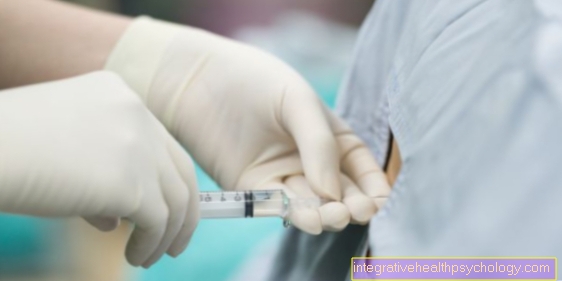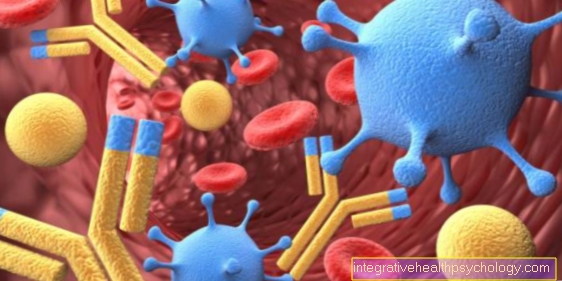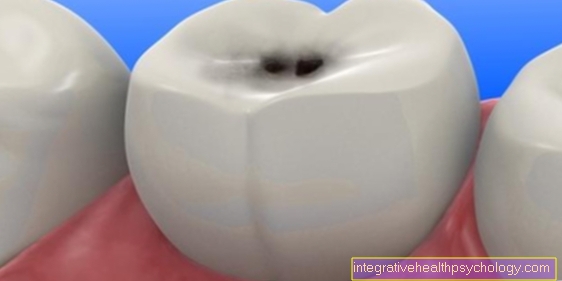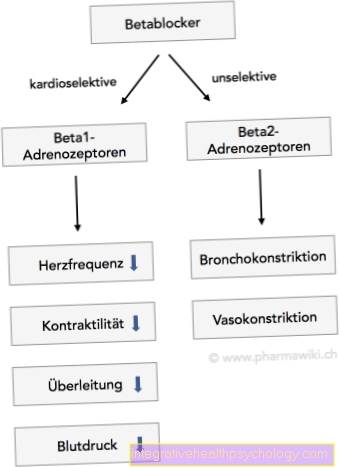Growth spurt
definition
A growth spurt is understood to mean a significant increase in the rate of growth, mostly related to the increase in body size per unit of time. But body weight and head circumference are also important for assessing growth in children. In humans, the growth spurts usually take place at certain stages of life. Babies grow fastest immediately after birth and young people between the ages of 12 and 15 grow particularly quickly in a relatively short time. In girls, the growth spurt usually begins about two years before the boys, but is usually less pronounced.

The growth of children and adolescents is determined by the doctor using so-called percentiles according to the Body size determination documented and compared. The average body size or body weight of a cohort of the same age is plotted on this and thus simplifies the assessment in each individual case.
If the body size deviates significantly from the norm, one could Growth disorder exist.
causes
Growth hormones such as somatotropin are particularly important in human growth. A deficiency in these hormones leads to short stature, while an excess leads to giant stature.Somatotropin is formed in the pituitary gland (pituitary gland) and can be released either more or less by various stimuli. An increased release of somatotropin from the gland can be caused by a lack of energy substrates, by exercise or fasting, a protein-rich diet, psychological stress or fever. Whereas somatostatin, an inhibiting hormone, reduces the release of somatotropin.
Read more on the topic: Growth hormones
Physiologically, most of the somatotropin is formed in the pituitary gland during sleep.
The age with the highest production of this hormone is puberty, as the sex hormones such as estrogens and androgens that are increasingly formed there stimulate the release of growth hormones.
Symptoms
Overall, the big growth spurts can be divided into three phases: those in babies, in toddlerhood and in puberty.
In the first two years of life, babies go through about eight growth spurts. This is also summarized as the first phase of growth spurts, and it is during this time that the children will grow the fastest in your life. On average about 43 centimeters per year, then a little less from year to year. The growth spurts during this time usually last about a week and occur at one to two month intervals. Usually there is a physical as well as a mental development boost. Nerve growth also plays an important role here, which children often find confusing and annoying. This is also reflected in the behavior. In this phase, the children are usually cranky and more exhausting than usual. They cannot sleep so well and are increasingly looking for constant contact with their caregivers. They are more affectionate and the mood is very changeable. Babies often get more hungry during a growth spurt and have to be breastfed more often than usual.
The second major growth phase begins from the age of three and lasts until puberty. During this time, children continue to grow steadily, but strong growth spurts are rather unusual. On average, the body length gain in this phase is around five to six centimeters per year.
The third and final phase of growth is during puberty and begins a little earlier in girls than in boys, usually about two years before that. This growth spurt is also known as the "pubic growth spurt". In girls it usually occurs at the age of 13 and from this point on they grow an average of 15 to 20 centimeters. From the age of 14, boys usually grow about 20 to 25 centimeters.
So on average about seven to nine centimeters per year. At the end of puberty, the final height is usually reached. For girls this is around the age of 15 and for boys around the age of 17. In addition to the externally visible change in body size, bone or joint pain in the form of growing pains can also occur during a growth spurt. Increased appetite and tiredness are also possible.
Read more on the topic: Growing pains
These symptoms show a growth spurt
When a baby is in a growth spurt, it usually shows typical behavior that shows an increase in growth. It is possible that the child sleeps less or at shorter intervals than usually. Particularly noticeable and associated with the shorter sleep phases is the increase in appetite. Young children and infants are often more clingy and cry more during growth phases. During puberty, there may be a growth spurt from sleeping more and growing pains in the legs or arms.
Does a growth spurt have a fever?
Fever during growth spurts is unusual and in most cases has a different cause. Children can develop a fever for many reasons, sometimes unrecognizable. From 37.5 ° C one speaks of increased temperature and from 38 ° C of fever. It shows the body's natural defense reaction to germs and is an important part of the training of the immune system, especially during development.
In principle, fever does not need to be clarified or treated by a doctor immediately. However, it is advisable to consult a pediatrician if the patient does not respond to lowering the fever, has a high fever of more than 39 ° C, has febrile convulsions or feels very ill. Paracetamol is recommended as a fever reduction, which can be given in consultation with the doctor and adapted to the weight of the child.
Do you have circulatory problems during the growth spurt?
Circulatory problems can occur during a growth spurt, especially in connection with puberty. Syncope (short-term unconsciousness) occurs when there is a sudden reduction in blood flow to the brain.
The reason for this is the adaptation of blood volume and blood pressure, which is still taking place, to increase in length with additional trigger factors such as menstruation, long standing, too little drinking or hypoglycaemia. Even if in most cases no worrying reasons for the syncope can be determined, diseases such as heart problems should be excluded.
Growing pains
Growing pains often occur during strong growth phases in a child's development. They are characteristic nocturnal occurrence and the localization in the Legswhat often with the feeling of a nocturnal Calf cramp is compared. However, the pain disappears quickly after a few minutes.
Many children feel Massage, warmth and care in acute pain as relieving. If this pain occurs frequently, you should talk to you Pediatrician because other diseases can also trigger such pain and should or can possibly be treated. A cause for the development of growing pains has not yet been found, since normal growth does not actually cause pain.
Read more on the subject at: Growing pains
Does a growth spurt also lead to growing pains?
Some children may experience growing pains during a growth spurt. These pains characteristically occur between late afternoon and evening, and occasionally children wake up from the pain at night.
In fact, this form of pain is one of the most common in children. Typically the muscles of the calves and thighs hurt, not the joints.
If there are accompanying symptoms such as a high fever, rashes or severe pain during the day, there is probably another cause and it is advisable to see a pediatrician.
Even if the pain occurs over a longer period of time and the child is unusually weak, further diagnostics must be carried out.
Read more on the topic: Pain while growing
Baby growth spurt
Newborns experience many growth spurts, especially in the first year of life. These are usually divided into eight different growth phases. The duration of an episode can vary widely, from 3 days to 4 weeks. As a rule, these growth phases in babies go together not only with growth in height, but also with motor and mental achievements and certain behavioral patterns.
Just as there is a great need for closeness to the mother in the first growth spurt and the child begins to recognize the mother by its smell, a pronounced 'strangeness' is characteristic of the second phase. The third phase is characterized by a greater appetite for milk or the gradual cessation of rituals, such as afternoon nap. The fourth growth phase usually begins between the third and fourth months of life, during which the baby often grows very quickly and restless nights are the order of the day.
The next phase is mainly characterized by the gain in motor skills, such as turning independently and the first crawling exercises. In addition, the first efforts to speak take place, even if at the beginning there are more individual syllables. By the end of the sixth phase (around 9 months), most babies can now crawl. But a certain understanding of the parents' reaction is now also established in the newborn. Clear signals such as 'Yes' or 'No' are slowly being understood.
Often times, babies can speak their first word after the seventh growth spurt. However, this phase is often accompanied by fits of anger. At the end of the eighth phase, many babies can now walk slowly, but there is often a renewed strangeness.
Please also read our topic:
- Baby growth spurt
and - Development of the child
The growth phases of babies again at a glance:
- Phase 1: From the 5th week onwards, babies smile and are more attentive. Above all, they often need breast milk and physical closeness.
- Phase 2: From the 8th week onwards, babies become strangers and develop the ability to see colors. The children can now be soothed with toys.
- Phase 3: From the 3rd month the babies get hungry faster and are more often tearful. You should slowly get used to rituals.
- Phase 4: Between the 3rd and 4th month the nights of the children become more restless, patience and physical closeness can help here.
- Phase 5: Between the 6th and 7th month, the children start crawling and turning and start their first attempts at speaking. Encouraging children is particularly important at this stage.
- Phase 6: From the 9th month, the children speak their first sentences and move more and more independently. Clear rules should be introduced now.
- Phase 7: From the 11th month onwards, babies improve their motor skills even more, lots of toys are good occupation and tasks can already be assigned.
- Phase 8: Between the 13th and 14th month, the children become more and more moody and the defiant phase begins. Here, too, patience and, above all, clear boundaries are helpful.
Growth spurt in the toddler
The different growth phases in small children no longer follow a precise sequence, as is the case with newborns. However, the individual phases also have marked changes in the child's behavior, but the order differs from child to child.
The development is also influenced by external influences, such as the presence of larger siblings, whether the child is in a daycare center and the relationship with the parents. The defiant phase is very exhausting for many parents. The child often stubbornly ignores the parents and usually reacts to words like '' No '' with defiance and anger. The point here is that the child tries to find its own limits and assert its own needs.
Find out more about the topic here: Defiance phase
In contrast, children in the clinging phase often long for a close relationship with their parents. This is the time when children come to their parents at night and want to sleep in their parents' bed. This phase is perceived by many parents as very harmonious.
During isolation, children want to do things on their own without their parents. The child's self-confidence is strengthened here and slowly begins to establish social contacts in kindergarten. But even a phase of strong physical growth is not long in coming. For many children this is also associated with pain. These occur mainly at night and often disappear after a few minutes. If the pain becomes too severe, you should consider consulting a pediatrician.
Growth spurt in puberty
Puberty usually occurs at the age of 10 in girls and not until two years later in boys. This phase is characterized by strong physical and psychological changes in the children. The main focus of physical change is the complete development of the genital organs and growth in height.
You can find more on the subject under: Puberty
Breasts begin to grow in girls and, after a certain time, regular bleeding begins, which is a sign of sexual maturity. In addition, girls notice the first signs of pubic hair from here.
In boys, the testicles initially develop and become larger. This process goes hand in hand with the growth of the penis. At around 13 years of age, the body begins to produce sperm. In addition, boys break their voices during this time and the beard slowly begins to grow.
Girls and boys also show pronounced growth in height of approx. 10-12 cm per year, but the point in time can vary greatly. The focus of the psychological changes is primarily on developing one's own personality, separating oneself from the family and a more reflective consideration of one's own behavior and its consequences.
When does adolescent growth occur in girls?
Girls have the last big growth spurt after they enter puberty at an average age of around 13 years. That's about two years before the boys' adolescent growth spurt. During puberty, the sex hormones estrogen and progesterone are increasingly released, which also stimulates the production of some growth hormones. Thus, a growth in length and the further development of the genital organs take place at the same time. Two years after their first period, most girls stop growing.
When does adolescent growth spurt in boys?
Boys can grow another 6 to 8 inches in their last growth spurt during puberty. At the age of 11-14 (sometimes later) boys can reach puberty and an average of two years after entry there is then a growth spurt. As with girls, the sex hormone cycle in boys is also linked to that of growth hormones, so that as the sexual organs mature, they grow in length in parallel.
therapy
Growth spurts are usually biologically pre-programmed and necessary for the healthy physical and mental development of children and adolescents.
In some cases, however, it may be that these do not run properly, are either too strong or too weak and can possibly be accompanied by further complications. These may require targeted therapy.
Read more on the subject under: Growth disorder
The lateral curvature of the spine (scoliosis) increases most during the pubic growth spurt. If this phase runs unevenly or particularly quickly, it can lead to an imbalance and cause back pain. If the scoliosis is severe and growth is not yet complete, physiotherapy and wearing a corset may be necessary, for example. In very extreme cases, the spine may even have to be surgically straightened.
Knock knees and bow legs are also relatively common in small children. Shortly after the start of the run, knock knees are even the normal finding. This usually corrects itself up to the age of six and does not require any further therapy. If, however, there is no spontaneous correction or if the misalignment is even increasing, regular check-ups should take place. If the malalignment of the leg is corrected in prepubertal growth, it can be straightened relatively easily in a small surgical procedure. If the growth is complete, however, it usually requires several extensive interventions.
Pathological short stature (short stature) or tall stature (tall stature) is also conceivable in children and adolescents. One speaks of this when the child is one of the three percent smallest or tallest among their peers. The reason for this can be a deficiency or excess of growth hormones, which can be treated with medication. On the one hand, there are artificially manufactured growth hormone preparations that, with reduced production by the body, can help to achieve relatively normal growth in height. This can be the case, for example, in the context of an underactive thyroid, delayed puberty or other chronic diseases. On the other hand, extremely rapid growth can be slowed down by drugs. This is sometimes necessary when a very large body is expected and the growth spurts are so rapid that they cause additional discomfort. For example, this can prevent the development of scoliosis or reduce its severity, which otherwise often causes lifelong back problems for those affected.
An excess of growth hormones is also conceivable in the case of a tumor of the pituitary gland. Both short and tall stature can also be hereditary and must therefore be clarified in detail in each individual case. Drug therapy involves interfering with the hormonal balance and should therefore only be carried out on the advice of a doctor and under strict supervision.
How long does a growth spurt last?
Infants grow a lot in the first year and go through several growth spurts. As a rule, a growth spurt only lasts a few days.
Of course, this cannot be generalized. Sometimes it is also difficult to differentiate between a growth spurt and the process of teething in young children, especially when these phases merge into one another. After this first large growth phase with length increase in phases, the children then grow steadily about 5 cm per year until they reach the next significant growth phase.
Are there really 8 growth spurts?
Scientifically not yet explained, but what many parents have observed in common is that many infants experience 8 marked growth spurts in the first two years of life. Often these phases of increased growth in length and possibly increased appetite coincide with the so-called milestones of development. These describe important development steps in the area of motor skills, language and social behavior. These too are not infrequently accompanied by certain behaviors, such as increased crying, stubbornness or strangeness.

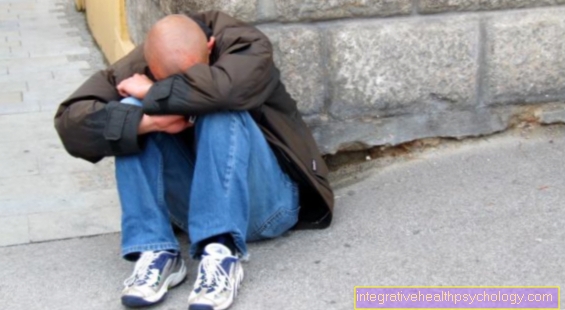


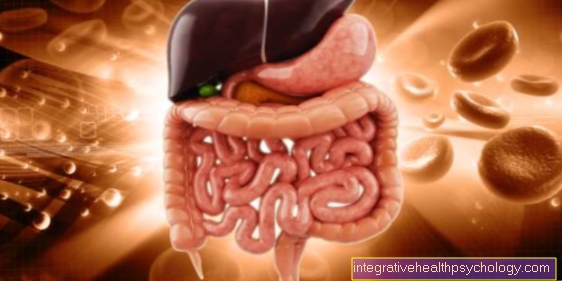

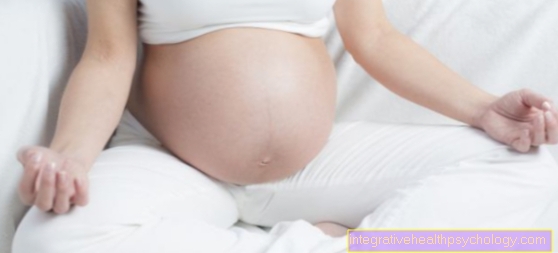



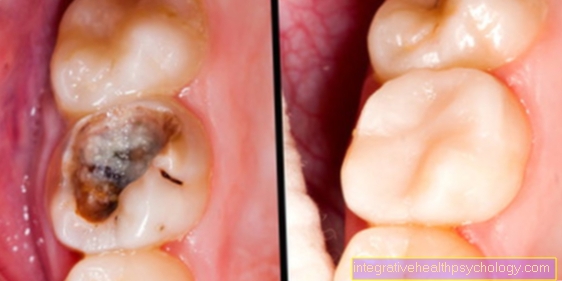



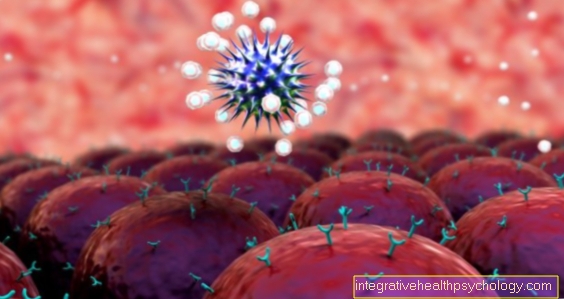
.jpg)





